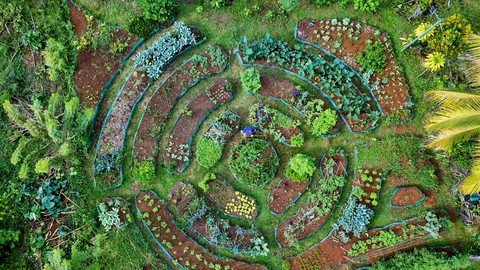

Published 3/2024
MP4 | Video: h264, 1920×1080 | Audio: AAC, 44.1 KHz
Language: English | Size: 1.26 GB | Duration: 2h 12m
Practical Applications and Case Studies in Permaculture Design
What you’ll learn
Gain a deep understanding of the principles and ethics that guide permaculture design.
Explore a variety of design techniques and strategies used in permaculture.
Learn how to assess and manage land sustainably by incorporating practices.
Discover how permaculture principles can be applied to build resilient communities.
Requirements
No experience needed, we will teach you everything you need to know.
Description
"Permaculture Design Mastery: Creating Thriving Ecosystems" offers a deep dive into the principles, techniques, and applications of permaculture a holistic approach to sustainable living and land management. This comprehensive course equips participants with the knowledge, skills, and inspiration to design and implement regenerative landscapes that support biodiversity, food production, and community resilience.Throughout the course, participants will explore the core principles of permaculture, including observation, mimicry, diversity, and resilience, and learn how to apply these principles to create thriving ecosystems. Through a combination of engaging lectures, hands-on activities, and real world case studies, students will delve into topics such as soil regeneration, water harvesting, agroforestry, natural building, and community development.This course provides practical tools and techniques for assessing landscapes, analyzing design elements, and crafting effective permaculture designs tailored to specific contexts and goals. Participants will gain insights into the interconnectedness of ecological systems, human needs, and social dynamics, and learn how to foster synergy and harmony between them.Whether you’re a beginner enthusiast, a seasoned gardener, or a community organizer, this course is designed to meet you where you are on your journey towards sustainability and empowerment. By the end of the course, you’ll emerge with the confidence and skills to become a steward of the land, a catalyst for positive change, and a leader in creating resilient and thriving ecosystems in your own community and beyond. Join us and embark on a transformative journey towards a more sustainable and regenerative future.
Overview
Section 1: Introduction
Lecture 1 Course Introduction
Lecture 2 History and origins of permaculture
Lecture 3 Advantages of permaculture
Section 2: Observation and Site Analysis
Lecture 4 Importance of observation in permaculture
Lecture 5 Site assessment techniques
Lecture 6 Identifying key elements
Section 3: Designing with Nature
Lecture 7 Working with natural patterns and processes
Lecture 8 Zones and sectors, organizing your space efficiently
Lecture 9 Utilizing vertical space and edge effects
Section 4: Soil Health and Regeneration
Lecture 10 The importance of soil in permaculture
Lecture 11 Building healthy soil with composting, mulching, and vermiculture
Lecture 12 Soil regeneration techniques
Section 5: Water Management
Lecture 13 Capturing and storing water
Lecture 14 Rainwater harvesting systems
Lecture 15 Greywater recycling and treatment
Section 6: Integrated Pest Management
Lecture 16 Understanding pests and beneficial organisms
Lecture 17 Designing pest resistant systems
Lecture 18 Companion planting and biodiversity for pest control
Section 7: Food Forests and Agroforestry
Lecture 19 Creating diverse and productive ecosystems
Lecture 20 Plant guilds and polycultures
Lecture 21 Incorporating perennial crops and trees into your design
Section 8: Renewable Energy and Appropriate Technology
Lecture 22 Harnessing renewable energy sources
Lecture 23 Low tech solutions for sustainability
Lecture 24 Designing for energy efficiency and resilience
Section 9: Community and Social Permaculture
Lecture 25 Building resilient communities
Lecture 26 Sharing resources and knowledge
Section 10: Putting Permaculture into Practice
Lecture 27 Designing your permaculture project
Lecture 28 Implementation strategies
Lecture 29 Monitoring, adapting, and continuous improvement
Individuals passionate about sustainable living, ecological stewardship, and regenerative practices who want to deepen their understanding of permaculture principles and techniques.,Seasoned or aspiring gardeners and farmers seeking to integrate permaculture design into their practices to enhance soil health, biodiversity, and productivity while minimizing environmental impact.,Community organizers, educators, and activists interested in fostering resilience, social cohesion, and sustainable development within their communities through permaculture inspired approaches.
https://rapidgator.net/file/a9efa837a4a8573248f29ca4dfa4cbb3/BKW2dKMj__Permacultu_MEGADDL.NET.part1.rar.html
https://rapidgator.net/file/3738a11c8e96f3b1b2f6e9ecf3f14471/BKW2dKMj__Permacultu_MEGADDL.NET.part2.rar.html
ddownload
https://ddownload.com/hf2jlw1rvoce/BKW2dKMj__Permacultu_MEGADDL.NET.part1.rar
https://ddownload.com/fffp8wzgfbut/BKW2dKMj__Permacultu_MEGADDL.NET.part2.rar
















Join the Conversation!
or
to post a comment